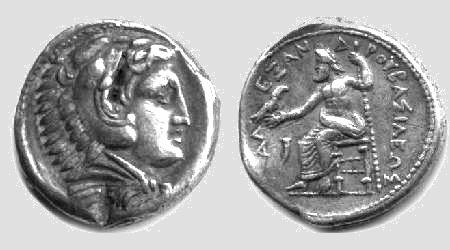
Alexander III the Great is not only the Ruler of a Wide Area Empire in the Antiquity. His presence in the History of the Western European Civilisation marks the end of the Greek classic age and opens the window on the Hellenistic Age.
Son of Philip II, he became King at the age of twenty, after Philip's assassination, in 336 B.C.
He continued his father's project to move eastward, against the Persian Kingdom.
He put himself , the Greek culture and Economy at the last eastern frontier of the World.
The Macedonian Military Power let him to project a great Empire in every detail, as Economy, Administrative Organisation. Science, Geography and the usefulness of a good monetary system.
With a true Blitz Krieg, the Army of Alexander III, using the tactics and the organization of the Phalanx (Infantry), and the joint power of the Cavalry, conquered in few years the Asia Minor and the Egypt; then the whole Persian Empire, reaching the farther regions of the actual Afghanistan, Uzbekystan, Tadjikistan, Pakistan and India.
He founded many cities, and some of them recall today the name of the Great, as Alexandria in Egypt, the best known, or Iskenderun in Turkey. The pilots who reached Baghdad during the Gulf War, could remember an objective called Aliskandariyah (Al Iskandar is the Arab form for Alexander).
We often look at the great rulers of the Antiquity as at rough and brutal men, only able to win battles, but Alexander has been a pupil of Aristotle, and he learnt by him the Physics, the Economy, the art of ruling peoples, and not only the Philosophy!
The coins of Alexander III and his portrait have been object of interest and study since the late Antiquity. His image, struck in gold or silver has been considered as an amulet and many rulers of the Antiquity, as Augustus and Caracalla have been attracted by the Alexander's character.
Alexander’s coinage is still perhaps an open question. After the Studies of Müller in the half 19th century and those of Martin Price in the last one, we can establish the right date and the Mint symbol of these coins.
But we cannot be sure about the beginning of his own coinage, the real meaning of the Coins Types and even about some Mint Mark correct attribution.
We must consider the economic meanings of Alexander's conquest: founding colonies and new cities, with the character of Greek way of life, he revitalized the lowering level of Greek cities' trade.
So his tetradrachms became the currency of Greece and of the former Persian Empire, and their typology became a topic for many decades after his death.
In this work we try to clear and summarise some concepts and data related to Alexander’s History, Coinage and Biography, to stimulate interest on the Great Alexander and, particularly, on his original and attractive tetradrachms.

HOME PAGE | 
STORIA | 
BIOGRAFIA | 
MONETAZIONE | 
BIBLIOGRAFIA |


